#ngc 1555
Text

Star T Tauri in NGC 1555: wild as dust ©
#nebula#stars#space#astrophotography#night sky#solar system#universe#planet#galaxy#astronomy#cosmos#ngc 1555
846 notes
·
View notes
Text

Hind's Variable Nebula, NGC 1555 // Rocco Sung
#astronomy#astrophotography#nebula#reflection nebula#variable nebula#hind's variable nebula#NGC 1555#Sh2-238#taurus
96 notes
·
View notes
Text
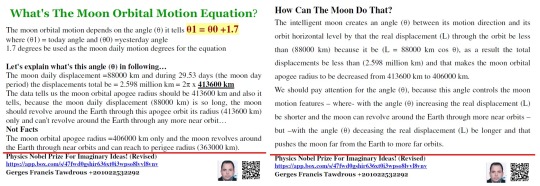
Best Regards
Can The Sun Rays Be Created By The Gravitational Waves Motions Energies?
or
or
or
or
My theory (the hypothesis)
The Sun Is A Phenomenon Created By The Planets Motions
The Sun Is NOT Doing Nuclear Fusion To Produce Its Rays- instead- The Planets Motions Energies Total Is Used To Produce The Sun Rays
The sun is a phenomenon created by the planets motions – the sun is created after all planets creation and motion – the sun is a phenomenon and its life and death depends on a cycle-means- after this sun death another sun will be created for the solar system
(No Planet Moves By The Sun Gravity– Newton is wrong)
The Sun Rays Production Machine Details
The Sun Rays Are Produced By The Gravitational Waves Motion
The Proof
This Is Extraordinary: Gravity Can Create Light, All on Its Own
https://www.msn.com/en-us/news/technology/this-is-extraordinary-gravity-can-create-light-all-on-its-own/ar-AA19YL5d?ocid=hpmsnHYPERLINK "https://www.msn.com/en-us/news/technology/this-is-extraordinary-gravity-can-create-light-all-on-its-own/ar-AA19YL5d?ocid=hpmsn&cvid=620db4352aa943e2b454919a7b724604&ei=83"&HYPERLINK "https://www.msn.com/en-us/news/technology/this-is-extraordinary-gravity-can-create-light-all-on-its-own/ar-AA19YL5d?ocid=hpmsn&cvid=620db4352aa943e2b454919a7b724604&ei=83"cvid=620db4352aa943e2b454919a7b724604HYPERLINK "https://www.msn.com/en-us/news/technology/this-is-extraordinary-gravity-can-create-light-all-on-its-own/ar-AA19YL5d?ocid=hpmsn&cvid=620db4352aa943e2b454919a7b724604&ei=83"&HYPERLINK "https://www.msn.com/en-us/news/technology/this-is-extraordinary-gravity-can-create-light-all-on-its-own/ar-AA19YL5d?ocid=hpmsn&cvid=620db4352aa943e2b454919a7b724604&ei=83"ei=83
This new article tells - the gravitational waves can move by high velocity motion and can produce A Light Beam– means- the light beam can be created by high velocity motion.
I claim the Sun Rays Are produced by this method and the Sun is NOT Doing Nuclear Fusion to produce its rays.
Shortly- The Sun Rays Are Produced By The Gravitational Waves Motion Energy And No Nuclear Fusion Is Used For The Sun Rays Production.
There are relativistic effects in the solar system proves a high velocity motion is found in the solar system- that supports the article discovery- means- because the gravitational waves move by high velocity– this motion causes to create the relativistic effects which effect on the planets data- and this high velocity motion causes to produce the light beam (The Sun Rays)
(I prove the relativistic effects are found in the solar system in POINT NO.5)
Conclusion No.1- The article changes the light beams production machine from (The Sun Nuclear Fusion) into (The Gravitational Waves High Velocity Motion) – that disproves Immediately The Sun Nuclear Fusion Theory
The Gravitational Waves Are Produced By The Planets Motions Energies and NOT by The Sun Gravitational Field- Moreover - The Sun doesn't create a gravitational field- this fact I prove it here by many major proves (Point NO.1)
Conclusion No.2- My theory tells (The Gravitational Waves Are Produced By The Planets Motions Energies And Not By The Sun Gravitational Field)
This theory changes the sun rays source of energy- in place of the sun mass which is used in (the sun nuclear fusion) to produce the sun rays-
The fact is that- the planets motions energies total is used as the source of energy to produce the sun rays-
Means
The Light Beam Production Machine And Source Of Energy Are Changed Prove That The Sun Nuclear Fusion Theory Is A Fake And Wrong Theory.
Shortly
The Sun Is A Phenomenon Created By The Planets Motions- And The Sun Rays Is Created By The Planets Motions Energies Total-
The Sun Rays are produced by the planets motions energies total (The proves discussion) (Point NO.2)
The gravitational waves move by speed of light (300000 km/s) depends on the planets motions (Point NO.3)
The Planets Motions Use Different Rates Of Time (Point NO.4)
Preface (Proved Facts)
The Rate Of Time Use Reason (The Solar System Creation Theory)
The Planet Creation and Motion Description
The Difficulty To Prove The Rate Of Time Use
The Rate Of Time Importance And Creation
The Energy Reflection Effect On The Rates Of Time
(The Energy Reflection is explained and proved in Point No.6)
The Solar System Main Rates Of Time
The Solar System Motion Depends on Mercury Clock
The Time Creation In The Solar System
The Earth Motion Effect On The Planets Motions Rates Of Time
The Rate Of Time Between Mercury And The Earth
The Rate Of Time Between Mercury And The Sun
The Rate Of Time Between The Sun And The Planets
The Rate Of Time Between The Sun And The Earth
Mercury behaves in place of the sun and The Earth in place of the planets
The Rate Of Time Of Saturn
The Rate Of Time Of Mars
The Solar System Motion During 24 Hours Of Mercury Clock
The Rate of time (1=1461)
The Used Rate Of Time For The Sun Rays Production
The Relativistic Effects Proves (Point NO.5)
The Energy reflection Proves (Point NO.6)
THE MAIN DISCUSSION
(CONT)
Thanks a lot – please read
Physics Nobel Prize For Imaginary Ideas! (Revised)
or
Gerges Francis Tawdrous +201022532292
Peoples' Friendship university of Russia – Moscow
ORCID https://orcid.org/0000-0002-1041-7147
Facebook https://www.facebook.com/gergis.tawadrous
VK https://vk.com/id696655587
Tumblr https://www.tumblr.com/blog/itsgerges
Researcherid https://publons.com/researcher/3510834/gerges-tawadrous/
Livejournal https://gerges2022.livejournal.com/profile
box https://app.box.com/s/47fwd0gshir636xt0i3wpso8lvvl8vnv
Academia https://rudn.academia.edu/GergesTawadrous
Publications http://vixra.org/author/gerges_francis_tawdrous
#nebula#stars#space#astrophotography#night sky#solar system#universe#planet#galaxy#astronomy#cosmos#ngc 1555
1 note
·
View note
Photo

2023 November 23
Along the Taurus Molecular Cloud
Image Credit & Copyright: Yuexiao Shen, Joe Hua
Explanation: The cosmic brush of star formation composed this interstellar canvas of emission, dust, and dark nebulae. A 5 degree wide telescopic mosaic, it frames a region found north of bright star Aldebaran on the sky, at an inner wall of the local bubble along the Taurus molecular cloud. At lower left, emission cataloged as Sh2-239 shows signs of embedded young stellar objects. The region's Herbig-Haro objects, nebulosities associated with newly born stars, are marked by tell-tale reddish jets of shocked hydrogen gas. Above and right T Tauri, the prototype of the class of T Tauri variable stars, is next to a yellowish nebula historically known as Hind's Variable Nebula (NGC 1555). T Tauri stars are now generally recognized as young, less than a few million years old, sun-like stars still in the early stages of formation.
∞ Source: apod.nasa.gov/apod/ap231123.html
110 notes
·
View notes
Photo
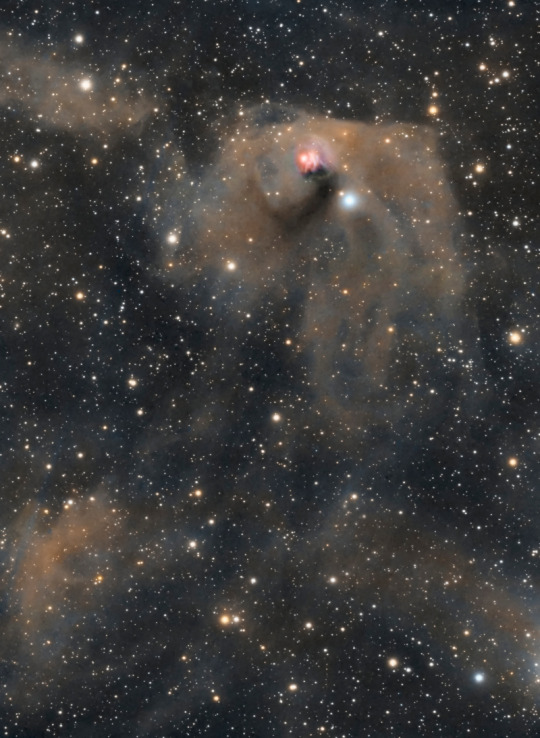
T Tauri and Hind s Variable Nebula : The star with an orange tint near top center in this dusty telescopic frame is T Tauri, prototype of the class of T Tauri variable stars. Next to it (right) is a yellow cosmic cloud historically known as Hind's Variable Nebula (NGC 1555). About 650 light-years away, at the boundary of the local bubble and the Taurus molecular cloud, both star and nebula are seen to vary significantly in brightness but not necessarily at the same time, adding to the mystery of the intriguing region. T Tauri stars are now generally recognized as young (less than a few million years old), sun-like stars still in the early stages of formation. To further complicate the picture, infrared observations indicate that T Tauri itself is part of a multiple system and suggest that the associated Hind's Nebula may also contain a very young stellar object. The well-composed image spans about 8 light-years at the estimated distance of T Tauri. via NASA
688 notes
·
View notes
Text

APOD November 23, 2023
Along the Taurus Molecular Cloud
The cosmic brush of star formation composed this interstellar canvas of emission, dust, and dark nebulae. A 5 degree wide telescopic mosaic, it frames a region found north of bright star Aldebaran on the sky, at an inner wall of the local bubble along the Taurus molecular cloud. At lower left, emission cataloged as Sh2-239 shows signs of embedded young stellar objects. The region's Herbig-Haro objects, nebulosities associated with newly born stars, are marked by tell-tale reddish jets of shocked hydrogen gas. Above and right T Tauri, the prototype of the class of T Tauri variable stars, is next to a yellowish nebula historically known as Hind's Variable Nebula (NGC 1555). T Tauri stars are now generally recognized as young, less than a few million years old, sun-like stars still in the early stages of formation.
©Yuexiao Shen
0 notes
Photo
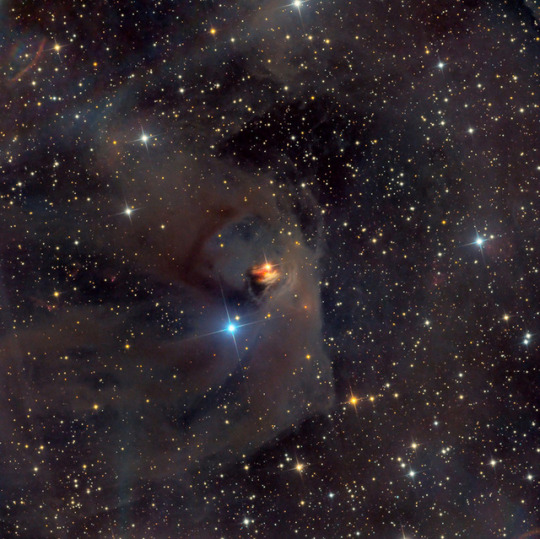
Hinds Variable Nebular, NGC 1555 in Taurus.
Credit: Warren Keller
#Space#Astronomy#Astrophotography#Hinds Variable Nebula#NGC 1555#Taurus#Warren Kellers#Stars#Universe#Cosmos#Night Sky#Constellation#Galaxy#Solar System#Deep Space#Science#Wonders#Photography#Nebula#Colors#Sparkle#Glow#billionsandbillions.com
2K notes
·
View notes
Photo
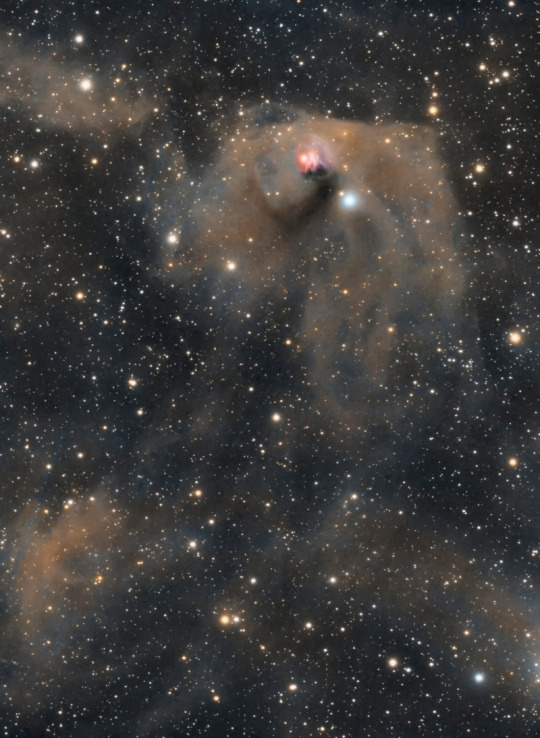
T Tauri and Hind s Variable Nebula via NASA https://ift.tt/ecigBGJ
The star with an orange tint near top center in this dusty telescopic frame is T Tauri, prototype of the class of T Tauri variable stars. Next to it (right) is a yellow cosmic cloud historically known as Hind's Variable Nebula (NGC 1555). About 650 light-years away, at the boundary of the local bubble and the Taurus molecular cloud, both star and nebula are seen to vary significantly in brightness but not necessarily at the same time, adding to the mystery of the intriguing region. T Tauri stars are now generally recognized as young (less than a few million years old), sun-like stars still in the early stages of formation. To further complicate the picture, infrared observations indicate that T Tauri itself is part of a multiple system and suggest that the associated Hind's Nebula may also contain a very young stellar object. The well-composed image spans about 8 light-years at the estimated distance of T Tauri.
(Published February 10, 2022)
32 notes
·
View notes
Text
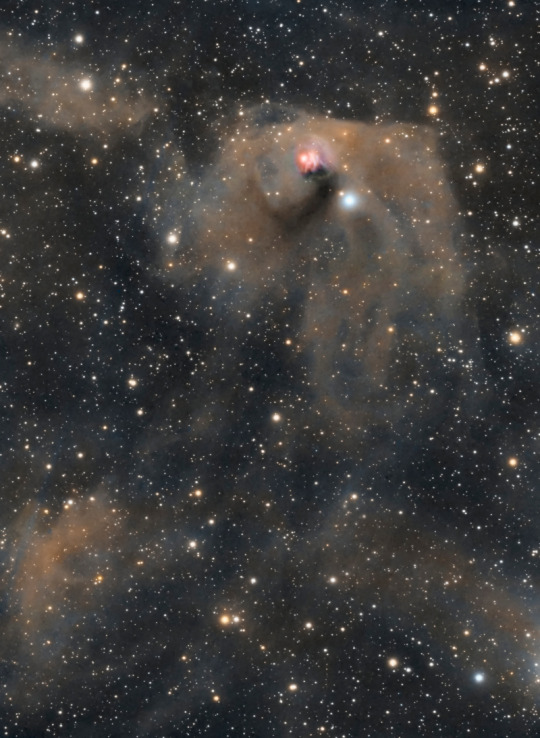
The star with an orange tint near top center in this dusty telescopic frame is T Tauri, prototype of the class of T Tauri variable stars. Next to it (right) is a yellow cosmic cloud historically known as Hind's Variable Nebula (NGC 1555). About 650 light-years away, at the boundary of the local bubble and the Taurus molecular cloud, both star and nebula are seen to vary significantly in brightness but not necessarily at the same time, adding to the mystery of the intriguing region. T Tauri stars are now generally recognized as young (less than a few million years old), sun-like stars still in the early stages of formation. To further complicate the picture, infrared observations indicate that T Tauri itself is part of a multiple system and suggest that the associated Hind's Nebula may also contain a very young stellar object. The well-composed image spans about 8 light-years at the estimated distance of T Tauri.
https://apod.nasa.gov/apod/ap220210.html?fbclid=IwAR3xvUQ71bqrhNUmZLLvCLGC9EzmUY0vj0QNAUdliGImqXqIC3PYrN00mfU
15 notes
·
View notes
Photo

German States, Leuchtenberg. Georg III. 1531-1555. AR taler. 1547. NGC certified VF details (scratches) Scarce. #numismatics #worldcoins #coins #coincollecting #ngccoin https://www.instagram.com/p/B8_-lwvHrtF/?igshid=1mcqpro79ly9o
1 note
·
View note
Photo
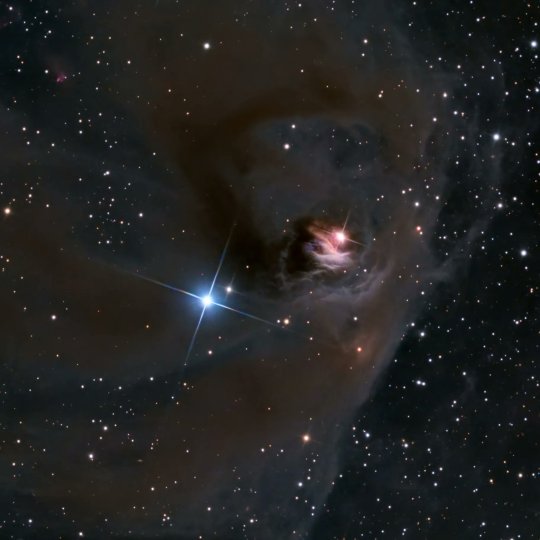
T-Tauri illuminated by Hind’s Variable nebula NGC 1555 © Kent Wood
#space#nasa#astrophotography#galaxy#nebula#planet#universe#planets#stars#night sky#cosmos#solar system#ngc 1555
718 notes
·
View notes
Text

Hind's Variable Nebula, NGC 1555 // wsg
#astronomy#astrophotography#nebula#reflection nebula#variable nebula#dust#interstellar dust#hind's variable nebula#NGC 1555#Sh2-238#taurus
49 notes
·
View notes
Photo



Taurus Constellation
Taurus constellation lies in the northern sky. Its name means “bull” in Latin. The constellation is symbolized by the bull’s head, .
Taurus is one of the 12 constellations of the zodiac, first catalogued by the Greek astronomer Ptolemy in the 2nd century. The constellation’s history, however, dates back to the Bronze Age.
Taurus is a large constellation and one of the oldest ones known. In Greek mythology, the constellation is associated with Zeus, who transformed himself into a bull in order to get close to Europa and abduct her.
Taurus is known for its bright stars Aldebaran, El Nath, and Alcyone, as well as for the variable star T Tauri. The constellation is probably best known for the Pleiades (Messier 45), also known as the Seven Sisters, and the Hyades, which are the two nearest open star clusters to Earth.
Taurus also has a number of famous deep sky objects, among them the supernova remnant Messier 1 (the Crab Nebula), Hind’s Variable Nebula (NGC 1555), the colliding galaxies NGC 1410 and NGC 1409, the Crystal Ball Nebula (NGC 1514), and the Merope Nebula (NGC 1435).
MYTH
Taurus constellation has been known since at least the Early Bronze Age, when it marked the Sun’s location during the spring equinox. It has been associated with the bull in many cultures and mythologies: Greek and Egyptian among other, and even going back to Ancient Babylon.
Depictions of Taurus and the Pleiades star cluster have even been found in a cave painting at Lascaux, dating back to 15,000 BC. Both the constellation and the Pleiades have been known in many indigenous cultures and referred to as the bull and the seven sisters, which indicates a common origin for the names.
In Greek mythology, Taurus is usually associated with Zeus, who adopted the shape of a bull in order to seduce and abduct Europa, the beautiful daughter of the Phoenician King Agenor.
Zeus mingled with the king’s herd and, being the most handsome bull there, he got Europa’s attention. The princess admired the bull and, when she sat on his back, he rose and headed for the sea. Zeus carried Europa all the way to the island of Crete, where he revealed his true identity and lavished the princess with presents.
The two had three sons together, including Minos, who grew up to be the famous king of Crete, who built the palace at Knossos where bull games were held and who also sacrificed seven young boys and girls to the Minotaur each year. Zeus later commemorated the bull by placing it among the stars.
Constellations Orion and Taurus, image: Dumbbell at wikipedia.org
An alternative interpretation associates Taurus with the nymph Io, whose line Europa was descended from, who was also seduced by Zeus and then transformed into a heifer when the two were nearly caught by Hera.
Babylonian astronomers called the constellation MUL.APIN, or “The Heavenly Bull.” In the Epic of Gilgamesh, one of the earliest literary works from Mesopotamia, Gilgamesh faces the Bull of Heaven sent by the goddess Ishtar to kill the hero after he had rejected her advances.
Gilgamesh is sometimes associated with the nearby Orion, another ancient constellation, and the two constellations are depicted as Gilgamesh and the bull in combat. (Source: Constellation Guide, temp.)
#29th#April#2018#April 29th 2018#why i love the zodiac signs#taurus#mine#Charlotte Wessels#delain#bono#u2#mother gaia
5 notes
·
View notes
Photo
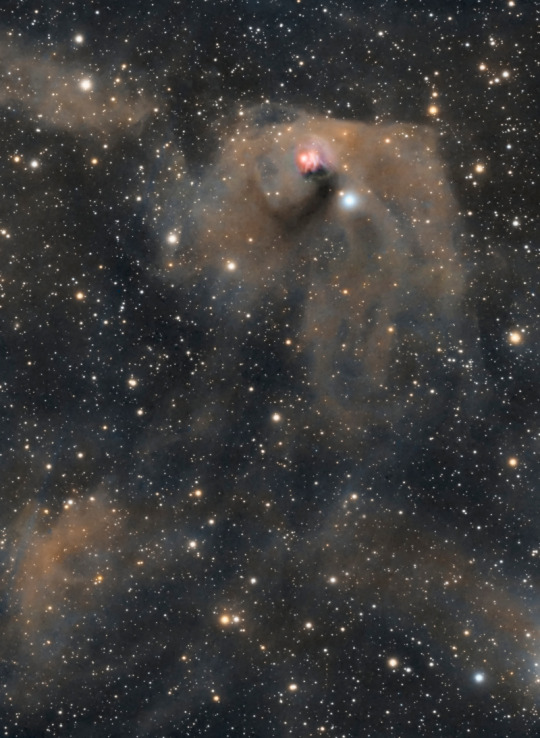
2022 February 10
T Tauri and Hind's Variable Nebula
Image Credit & Copyright: Dawn Lowry, Gian Lorenzo Ferretti, Ewa Pasiak and Terry Felty
Explanation: The star with an orange tint near top center in this dusty telescopic frame is T Tauri, prototype of the class of T Tauri variable stars. Next to it (right) is a yellow cosmic cloud historically known as Hind's Variable Nebula (NGC 1555). About 650 light-years away, at the boundary of the local bubble and the Taurus molecular cloud, both star and nebula are seen to vary significantly in brightness but not necessarily at the same time, adding to the mystery of the intriguing region. T Tauri stars are now generally recognized as young (less than a few million years old), sun-like stars still in the early stages of formation. To further complicate the picture, infrared observations indicate that T Tauri itself is part of a multiple system and suggest that the associated Hind's Nebula may also contain a very young stellar object. The well-composed image spans about 8 light-years at the estimated distance of T Tauri.
∞ Source: apod.nasa.gov/apod/ap220210.html
42 notes
·
View notes
Photo

T Tauri ve Hind’in Değişen Nebulası
Günün Astronomi Görseli 10 Şubat 2022
Görsel & Telif: Dawn Lowry, Gian Lorenzo Ferretti, Ewa Pasiak and Terry Felty
Bu teleskobik karenin üst merkezi yakınındaki turuncu tonlu yıldız T Tauri, yani T Tauri değişen yıldızlar sınıfının ilk örneği. Onun yanında (sağda), Hind’in Değişen Nebulası (NGC 1555) adıyla bilinen sarı bir kozmik bulut var. Yaklaşık 650 ışık yılı uzakta, yerel kabarcığın ve Taurus moleküler bulutunun sınırında, hem yıldız hem de nebulanın parlaklığı önemli ölçüde değişiyor gibi görünüyor, ama bunu aynı anda yapmıyorlar ve bu da ilginç bölgenin gizemini arttırıyor. T Tauri yıldızları artık genel olarak oluşumun erken evrelerinde olan, genç (birkaç milyon yıldan daha az), Güneş benzeri yıldızlar olarak tanımlanıyor. Resmi daha da karmaşık hale getirecek şekilde, kızılötesi gözlemler T Tauri’nin kendisinin bir çoklu yıldız sisteminin parçası olduğunu ve bağlantılı Hind’in Nebulası’nın da çok genç bir yıldız içeriyor olabileceğini gösteriyor. Bu iyi oluşturulmuş görüntü, T Tauri’nin tahmini mesafesinde, yaklaşık 8 ışık yılı boyunca uzanıyor.
Görsel & Telif: Dawn Lowry, Gian Lorenzo Ferretti, Ewa Pasiak and Terry Felty
Yazarlar & Editörler: Robert Nemiroff (MTU) & Jerry Bonnell (UMCP) NASA yetkilisi: Phillip Newman Özel haklara tabidir. NASA Web Gizlilik Politikası ve Önemli Bildirimler Bir ASD at NASA / GSFC & Michigan Tech. U. hizmetidir.
T Tauri ve Hind’in Değişen Nebulası yazısı ilk olarak Uzaydan Haberler sayfasında göründü.
0 notes
Text
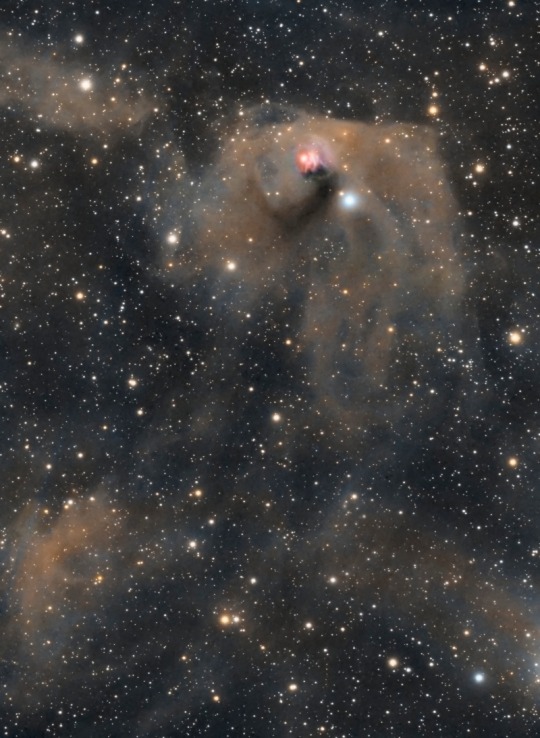
APOD: T Tauri and Hind's Variable Nebula (2/10/22)
The star with an orange tint near top center in this dusty telescopic frame is T Tauri, prototype of the class of T Tauri variable stars. Next to it (right) is a yellow cosmic cloud historically known as Hind's Variable Nebula (NGC 1555). About 650 light-years away, at the boundary of the local bubble and the Taurus molecular cloud, both star and nebula are seen to vary significantly in brightness but not necessarily at the same time, adding to the mystery of the intriguing region. T Tauri stars are now generally recognized as young (less than a few million years old), sun-like stars still in the early stages of formation. To further complicate the picture, infrared observations indicate that T Tauri itself is part of a multiple system and suggest that the associated Hind's Nebula may also contain a very young stellar object. The well-composed image spans about 8 light-years at the estimated distance of T Tauri.
© Dawn Lowry
0 notes